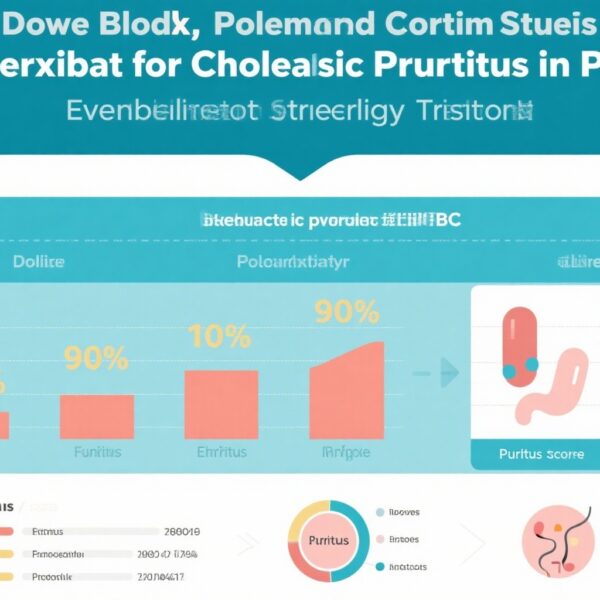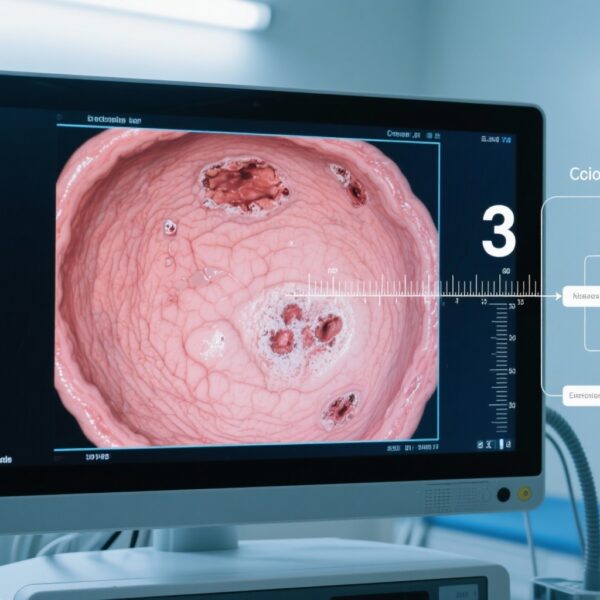Highlight
– In the phase 3 PRIMIS trial, cilofexor 100 mg daily did not significantly reduce the proportion of patients with histological fibrosis progression (Ludwig stage increase ≥1) at 96 weeks compared with placebo in non‑cirrhotic large‑duct primary sclerosing cholangitis (PSC).
– Fibrosis progression occurred in 31% of cilofexor‑treated patients versus 33% with placebo (treatment difference −1.4%; 95% CI −15.2 to 12.3; p=0.42); the study was stopped early for futility.
– Pruritus was the most common adverse event and was more frequent and sometimes more severe with cilofexor.
Background: the unmet need in PSC
Primary sclerosing cholangitis (PSC) is a progressive cholestatic liver disease characterized by fibro‑obliterative stricturing of the intra‑ and/or extrahepatic bile ducts. Many patients develop progressive fibrosis, portal hypertension, and ultimately cirrhosis; PSC is also strongly linked to inflammatory bowel disease and carries an increased risk of cholangiocarcinoma and colorectal neoplasia. There is no pharmacologic therapy conclusively proven to change the natural history of PSC. Therapeutic development has focused on modifying bile acid signaling, inflammation, and fibrogenesis.
Study design: PRIMIS phase 3 trial (overview)
PRIMIS was a randomized, double‑blind, placebo‑controlled, multicentre phase 3 trial conducted across 205 sites in 16 countries (ClinicalTrials.gov NCT03890120). Adults (18–75 years) with non‑cirrhotic (Ludwig F0–F3) large‑duct PSC were randomized 2:1 to cilofexor 100 mg once daily or matching placebo for 96 weeks. Randomization was stratified by ursodeoxycholic acid (UDCA) use and presence of bridging fibrosis (F3 versus F0–F2), with a block size of six within each stratum. Participants, site personnel directly involved in trial conduct, and outcome assessors were masked to assignment.
The predefined primary endpoint was the proportion of participants with histological progression of liver fibrosis at week 96, defined as an increase in Ludwig stage by one or more. The trial enrolled 419 participants (277 to cilofexor, 139 to placebo); 416 received at least one dose and were included in safety analyses. After an interim futility analysis based on 160 patients reaching 96 weeks, the trial was terminated early because the conditional probability of detecting a significant treatment benefit was low (6.8%; futility boundary ≤10%). The final primary endpoint analysis included participants who had paired baseline and week‑96 biopsies.
Key findings
Primary outcome
Of the participants with paired biopsies available for analysis (133 cilofexor, 64 placebo), histological fibrosis progression at week 96 occurred in 41 (31%) cilofexor‑treated patients and 21 (33%) placebo‑treated patients. The absolute treatment difference was −1.4% (95% CI −15.2 to 12.3), and the comparison was not statistically significant (p=0.42). Thus, cilofexor did not reduce the risk of histological fibrosis progression over 96 weeks in this non‑cirrhotic PSC population.
Safety and tolerability
The safety profile highlighted pruritus as the most common adverse event. Pruritus occurred in 49% of cilofexor‑treated participants versus 36% in placebo; grade 3 or higher pruritus occurred in 4% with cilofexor and 1% with placebo. Other common adverse events included COVID‑19 (23% cilofexor vs 19% placebo) and upper abdominal pain (14% both arms). Rates of serious adverse events were similar between groups (19% in each arm). There were no treatment‑related deaths. Overall, the trial provided valuable class‑level harms data for cilofexor and farnesoid X receptor (FXR) agonists more generally.
Interpretation of effect size and clinical relevance
The observed between‑group difference was small and statistically and clinically unconvincing. The confidence interval was wide and encompassed effects that would be clinically meaningful as well as harms, reflecting limited precision after early termination and incomplete biopsy sampling. Given the absence of a signal favoring cilofexor on the prespecified histological endpoint, the trial does not support cilofexor 100 mg daily as an antifibrotic therapy in non‑cirrhotic PSC when judged by Ludwig stage change over 96 weeks.
Expert commentary and contextualization
Mechanistic rationale: Cilofexor is a non‑steroidal FXR agonist. FXR is a nuclear receptor central to bile acid homeostasis, and FXR agonists can reduce bile acid synthesis and hepatic inflammation while modulating metabolic and fibrogenic pathways. These mechanisms provided biological plausibility for testing FXR agonists in cholestatic liver disease.
Why might a well‑rationalized agent fail to impact histological fibrosis in PSC? Several considerations are relevant:
- Endpoint selection and timing: Histological progression by Ludwig stage is a direct measure of fibrosis but is subject to sampling variability and interobserver differences. Fibrosis progression in PSC may be focal and patchy, and bile duct‑related architectural changes can be heterogeneously distributed. Ninety‑six weeks may be insufficient to detect consistent stage changes in a non‑cirrhotic population where progression can be slow.
- Power and early termination: The trial’s planned interim futility stopping reduced the number of evaluable paired biopsies, increasing uncertainty and widening confidence intervals. Early stopping for futility prevents accrual of more events that might clarify a small effect.
- Disease biology: PSC is a complex biliary disease with contributions from immune dysregulation, microbial factors, and biliary epithelial injury. A single pathway modulation (FXR signaling) may be insufficient to alter fibrosis progression in isolation.
- Class tolerability: Pruritus is a known, class‑effect adverse event for FXR agonists (reported with other agents such as obeticholic acid), potentially limiting tolerability and adherence in cholestatic populations that already often experience pruritus.
Strengths of PRIMIS include its randomized, double‑blind design; global, multicentre enrolment; stratified randomization by UDCA use and fibrosis stage; and the use of histological endpoints. The trial also provides important safety information on cilofexor in PSC.
Limitations include early termination that reduced sample size for the primary analysis, reliance on paired biopsies with potential sampling error, and lack of long‑term clinical endpoints (e.g., transplant, decompensation, cholangiocarcinoma). The amendment to include all who received at least one dose and had baseline and week‑96 biopsies for the primary analysis may have introduced additional complexity in interpretation.
Implications for practice and future research
For clinicians caring for patients with non‑cirrhotic PSC, PRIMIS indicates that cilofexor 100 mg daily should not be expected to prevent histological fibrosis progression over a 96‑week period. The increased frequency and severity of pruritus with cilofexor are clinically relevant when considering tolerability.
For researchers and sponsors, PRIMIS highlights key considerations for future PSC trials:
- Endpoint selection: Composite or surrogate endpoints that combine biochemical markers (e.g., alkaline phosphatase trends), noninvasive fibrosis measures (transient elastography, MR elastography), patient‑reported outcomes (pruritus), and hard clinical outcomes may provide a more robust assessment of benefit, especially when biopsy sampling is problematic.
- Longer follow‑up and larger event counts: PSC progression is often slow; longer trials or strategies focusing on higher‑risk subgroups might increase the likelihood of detecting clinically meaningful effects.
- Mechanistic strategies: Combination approaches targeting complementary pathways (anti‑inflammatory, anti‑fibrotic, microbiome modulation) may be necessary to alter disease course.
Conclusion
The PRIMIS phase 3 trial found no evidence that cilofexor 100 mg daily reduces histological fibrosis progression in patients with non‑cirrhotic large‑duct PSC over 96 weeks. Pruritus was more common and sometimes more severe with cilofexor. These findings do not support cilofexor for fibrosis prevention in this population and underscore the challenges of therapeutic development in PSC, including endpoint selection, disease heterogeneity, and drug tolerability. Future studies should prioritize validated surrogate endpoints, longer follow‑up, and combination strategies to address the multifactorial biology of PSC.
Funding and trial registration
Funding: Gilead Sciences.
ClinicalTrials.gov identifier: NCT03890120.
References
Trauner M, Levy C, Tanaka A, Goodman Z, Thorburn D, Joshi D, Salminen K, Yimam K, Isayama H, Montano‑Loza AJ, Caldwell S, Danta M, Farkkila M, Gallegos‑Orozco JF, Gordon SC, Hinrichsen H, Invernizzi P, Vuppalanchi R, Zhu K, Xu J, Liu X, Lu X, Crans G, Bolbolan S, Boyette L, Alani M, Barchuk WT, Watkins TR, Genovese MC, Bowlus CL. Cilofexor in non‑cirrhotic primary sclerosing cholangitis (PRIMIS): a randomised, double‑blind, multicentre, placebo‑controlled, phase 3 trial. Lancet Gastroenterol Hepatol. 2025 Oct 28: S2468‑1253(25)00208‑0. doi: 10.1016/S2468‑1253(25)00208‑0. Epub ahead of print. PMID: 41173015.



